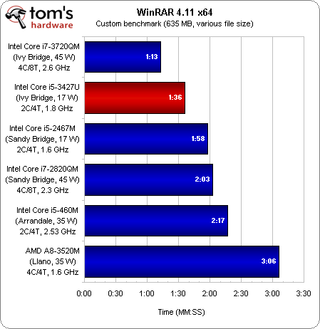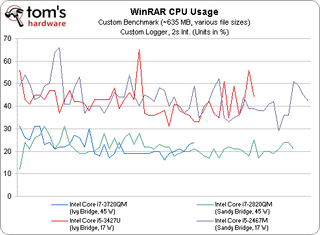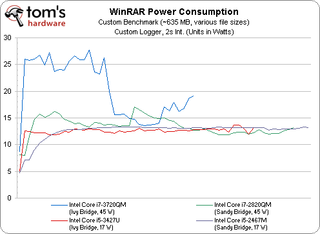Second-Generation Ultrabooks: Faster And Cheaper With Ivy Bridge
Benchmark Results: WinRAR
WinRAR is one of three archival apps normally included in our processor reviews. Historically, it took far better advantage of multi-core CPUs than WinZip, though Corel's recent 16.5 release improves that app's threading. WinRAR doesn't always scale as well as 7-Zip, though.

This title isn't without its quirks, though. For instance, the system built around Intel's 17 W Core i5-3427U predictably trails the 45 W Core i7-3720QM by 30% (~23 seconds). However, the Core i5-2467M, also a 17 W chip, surprisingly beats the Core i7-2820QM. In every way specification the i7 outclasses the i5, suggesting something wrong on our end. But we repeated the test several times to the same result.

We've never seen WinRAR achieve high processor utilization numbers. It's tempting to suggest a storage bottleneck, but even when we run this test from a RAM disk, CPUs tend to flounder about in the 50% range. Regardless, the outcome in WinRAR is similar to our Photoshop metric, with the quad-core chips tending to hover between 20 and 30% duty cycles, as the dual-core models are forced to work harder.
Both of the 17 W parts behave as we'd expect when we turn to power consumption, sipping energy until their respective workloads are finished. The 45 W models exhibit vastly different tendencies, though. The Ivy Bridge-based Core i7 platform spikes up, hurries through its task, and dips back down. Meanwhile, the chip employing Sandy Bridge maintains more conservative power use. It's punished for its moderation by a far worse performance result.

Stay on the Cutting Edge
Join the experts who read Tom's Hardware for the inside track on enthusiast PC tech news — and have for over 25 years. We'll send breaking news and in-depth reviews of CPUs, GPUs, AI, maker hardware and more straight to your inbox.
Current page: Benchmark Results: WinRAR
Prev Page Benchmark Results: Adobe Photoshop CS 5 Next Page Benchmark Results: iTunes-
sam_fisher It seems that Ivy Bridge's lower TDP and its HD 4000 comes into its own in the notebook/ultrabook market more so than the PC/gaming one.Reply -
sam_fisher crisan_tiberiuthey should use HD 4000 on every intel CPU, i dont get it why they dont ...Reply
The integrated graphics is built into the processor die and the changes between the HD 3000 and 4000 are physical changes, so they can't just change them without changing the whole CPU.
-
mayankleoboy1 crisan_tiberiuthey should use HD 4000 on every intel CPU, i dont get it why they dont ...Reply
Pricing, TDP, segmentation and PROFIT -
crisan_tiberiu sam_fisherThe integrated graphics is built into the processor die and the changes between the HD 3000 and 4000 are physical changes, so they can't just change them without changing the whole CPU. Yes, i know that :)) but when they designed IVY they should have designed every chip with the HD 4000. The HD 4000 is still outperformed by Liano iGPU if you remember...Reply -
tomfreak Cant u put an older/previous generation desktop and benchmark against it? I cant or couldnt get how a fast a 2.0GHz Ivy vs a similar Nehelem Desktop CPU vs desktop core 2 duo CPU. Many of us buy notebook to replace desktop for casual use, we would like to know what it can do vs our old desktop.Reply
Besides get some older AAA games to bench, nobody play BF3 at Ultra books with HD4000. We wanna see what old games we can max out @ full resolution. -
silverblue I think AMD missed a trick with Llano. Instead of throwing four lowly clocked cores at a mobile processor, perhaps two higher clocked cores would've made much more sense. That way, they could possibly sport a higher clock GPU as well within the same TDP.Reply
Trinity's lower powered, higher clocked cores already look to have partly made up for this, but until the 17W variant comes along, there's no real indication of how it'll measure up to IB ULV. However, we do know that AMD pairs the slower GPUs with the slower CPUs and vice versa, so there's little chance of a, say, 2C/2T/1M CPU with the 7660G GPU. -
DjEaZy ... ok... you compare the Llano to Sandy/Ivy bridge in CPU performance, but not in GPU performance? and why not Sandy/Ivy Bridge to Trinity?Reply
... and Adobe Photoshop CS 5? not CS 6?
Most Popular

